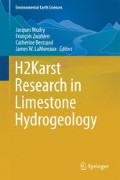Abstract
A geophysical survey routine is proposed to detect underground cavities and dolines, based on the sequential application of ground penetrating radar (GPR) and electrical resistivity imaging or tomography (RESTOM). A case study near Cherea area (NE Algeria) demonstrates the applicability of these methods. Nine GPR profiles and two-dimensional RESTOM have been applied, with relative success, to locate paleo-collapses and cavities, and to detect and characterize karst at two sinkhole sites near Cheria city where limestone is covered by about 10 m of clayey soils. The survey results suggest that GPR and RESTOM are ideal geophysical tools to aid in the detection and monitoring of sinkholes and other subsurface cavities.
Access this chapter
Tax calculation will be finalised at checkout
Purchases are for personal use only
References
Annan AP, Cosway SW, Redman JD (1991) Water table detection with ground-penetrating radar. In: Society of exploration geophysicists (annual international meeting program with abstracts), pp 494–497
Baali F (2001) Eude hydrogéologique hydrochimique de la région karstique de Chéria N-E Algérien. Magister Univ Annaba Algérie, p 100
Baali F, Rouabhia A, Kherici N, Djabri L, Bouchaou L, Hani A (2007) Qualité des eaux souterraines et risque de pollution en milieu semi aride. Cas de la cuvette de Chéria. NE algérien. J Estudios Geologicos 63: CSIC, Spain
Ballard RF (1983) Cavity detection and delineation research. Report 5, Electromagnetic (radar) techniques applied to cavity detection. Technical Report GL, 83–1, p 90
Barker R, Moore J (1998) The application of time-lapse electrical tomography in groundwater studies. Lead Edge 17(10):1454–1458
Beck BF (1991) On calculating the risk of sinkhole collapse. In: Kastning EH, Kastning KM (eds) Proceedings of Appalachian Karst Symp, Radford, Virginia, 23–26 March 1991. National Speleological Society, Huntsville, Alabama, pp 231–236
Benson RC, Kaufmann RD, Yuhr LB, Martin D (1998) Assessment, prediction and remediation of karst conditions on I-70, Frederick, Maryland, 49th Highway Geology Symposium, Precott, Arizona, 10–14 September 1998. Arizona Department of Transportation, Material Group, Arizona Geological Survey, pp 313–325
Bishop I, Styles P, Emsley SJ, Ferguson NS (1997) The detection of cavities using the microgravity technique: case histories from mining and karstic environments. Geol Soc Eng Geol Spec Publ 12:153–166
Butler DK (1984) Microgravimetric and gravity gradient techniques for detection of subsurface cavities. Geophysics 49(7):1084–1096
Burger HR (1992) Exploration geophysics of the shallow subsurface. Prentice-Hall, Englewood Cliffs, p 489
Chaffai H, Baali F, Djabri L, Rouabhia Aek (2003) Facteurs influençant le chimisme des eaux dans une zone semi-aride: Cas des aquifères d’El Ma El Abiod, Tébessa, Hammamet et Chéria. ICOWAP-Sep 2003. Colloque Oasis, Eau et population, Biskra Algérie, pp 339–344
Colley GC (1963) The detection of caves by gravity measurements. Geophys Prospect XI:1–9
Cook JC (1965) Seismic mapping of underground cavities using reflection amplitudes. Geophysics 30(4):527–538
Cook KL, Van Nostrand RG (1954) Interpretation of resistivity data over filled sinks. Geophys Prospect 21:716–723
Dahlin T (1996) 2D resistivity surveying for environmental and engineering applications. First Break 14:275–284
Dahlin T, Loke M (1998) Resolution of 2-D Wenner resistivity imaging as assessed by numerical modelling. J Appl Geophys 38:237–249
Fehdi Ch, Baali F, Boubaya D, Rouabhia A (2011) Detection of sinkholes using 2D electrical resistivity imaging in the Cheria Basin (North-East of Algeria). Arab J Geosci 4:181–187
Gaud J (1977) Etude géologique et hydrogéologique du plateau de Chéria Wilaya de Tébessa. Rapport interne No. 2. A.N.R.H de Tébessa (Agence Nationale des ressources hydriques), p 96
Griffiths DH, Barker RD (1993) Two-dimensional resistivity imaging and modeling in areas of complex geology. J Appl Geophys 29:211–226
Gutierrez A, Galve JP, Lucha P, Bonachea J, Jorda L, Jorda R (2009) Investigation of a large collapse sinkhole affecting a multi-storey building by means of geophysics and the trenching technique (Zaragoza city, NE Spain). Environ Geol 58:1107–1122
LaMoreaux PE, Wilson BM, Memon BA (1984) Guide to the hydrology of carbonate rocks. UNESCO, France
Mathé V, Léveque F, Mathé PE, Chevallier C, Pons Y (2006) Soil anomaly mapping using a caesium magnetometer: limits in the low magnetic amplitude case. J Appl Geophys 58:202–217
Rybakov M, Goldshmidt V, Fleischer L, Rotstein Y (2001) Cave detection and 4-D monitoring: a microgravity case history near the Dead Sea. Lead Edge (Soc Explor Geophys) 20(8):896–900
Rybakov M, Rotstein Y, Shirman B, Al-Zoubi A (2005) Cave detection near the Dead Sea-a micromagnetic feasibility study. The Leading Edge (Society of Exploration Geophysicists) 24(6):585–590
Sasaki Y, Matsuo K (1993) Surface-to-tunnel resistivity tomography at the Kamaishi Mine. Butsuri-Tansa 46:128–133
Spies B, Ellis R (1995) Cross-borehole resistivity tomography of a pilot sale, in situ vitrification test. Geophysics 60:886–898
Telford WM, Geldart LP, Sheriff RE (1990) Applied geophysics, 2nd edn. Cambridge University Press, New York
Van Schoor M, Duvenhage D (2000) Comparison of crosshole radio imaging and electrical resistivity tomography for mapping out disseminated sulphide mineralisation at a surface test site in Mpumalanga, South Africa. Explor Geophys 30:3–4
Vila JM (1980) La chaîne alpine de l’Algérie orientale et des confins Algéro-Tunisiens. Thèse de Doctorat- es-sciences, Université Pierre et Marie curie, Paris VI
Williams PW (1985) Subcutaneous hydrology and the development of doline and cockpit karst. Z Geomorphol NF 29(4):463–482
Zhou W, Beck BF, Adams AL (2002) Effective electrode array in mapping karst hazards in electrical resistivity tomography. Environ Geol 42:922–928
Author information
Authors and Affiliations
Corresponding author
Editor information
Editors and Affiliations
Rights and permissions
Copyright information
© 2014 Springer International Publishing Switzerland
About this chapter
Cite this chapter
Fehdi, C., Nouioua, I., Belfar, D., Djabri, L., Salameh, E. (2014). Detection of Underground Cavities by Combining Electrical Resistivity Imaging and Ground Penetrating Radar Surveys: A Case Study from Draa Douamis Area (North East of Algeria). In: Mudry, J., Zwahlen, F., Bertrand, C., LaMoreaux, J. (eds) H2Karst Research in Limestone Hydrogeology. Environmental Earth Sciences. Springer, Cham. https://doi.org/10.1007/978-3-319-06139-9_5
Download citation
DOI: https://doi.org/10.1007/978-3-319-06139-9_5
Published:
Publisher Name: Springer, Cham
Print ISBN: 978-3-319-06138-2
Online ISBN: 978-3-319-06139-9
eBook Packages: Earth and Environmental ScienceEarth and Environmental Science (R0)

